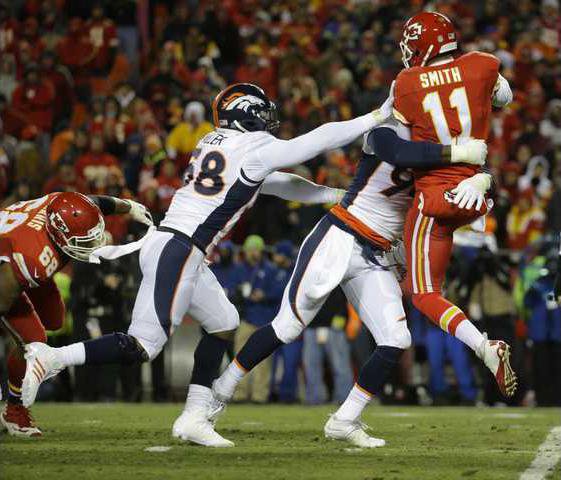KANSAS CITY, Mo. (AP) — Alex Smith took the snap in the shotgun, looked quickly to his left and flicked the ball to tight end Travis Kelce, who was pushed out of bounds after a gain of nearly 10 yards.
It was good for a first down. There was 4:37 left in the game and it was the Chiefs’ first third-down conversion against the Denver Broncos.
In the one-sided loss last Sunday that left Kansas City in playoff peril, the inability of the Chiefs’ offense to sustain drives was one of the biggest problems. That pass to Kelce was not only the first time they converted on third down, it was the only time in nine tries — precisely the kind of inefficiency that Smith and coach Andy Reid have built reputations on avoiding.
“We’ve got to sustain drives,” Reid said. “That’s been one of our strengths and the last couple of weeks we haven’t done that. That’s my responsibility, to get the guys in the right positions to keep the chains moving. We’ve had way too many three-and-outs.”
In fact, the Chiefs went three-and-out the first three times they had the ball in that 29-16 loss to Denver. By the time they picked up a first down midway through the second quarter, Peyton Manning had already launched the Broncos to a 17-0 lead and silenced Arrowhead Stadium.
The problems were just beginning for Kansas City, though.
After picking up that initial first down, they picked up nine yards on its next two plays, leaving the Chiefs with third-and-1. It should have been a simple conversion, especially with one of the best running backs in the league in Jamaal Charles. Instead, Charles was stuffed at the line of scrimmage and the Chiefs were 0 for 4 on third-down conversions.
Charles wound up scampering for a first down given a second chance on fourth-and-1. So the Chiefs were far better at converting fourth down than third.
“There’s a lot that goes into it,” Smith said. “Being better on first and second down is important, and starting off and putting ourselves in good positions, and staying on schedule. You put yourself in better third downs over the long run you’re going to convert more.”
It wasn’t just that Kansas City was repeatedly stopped short on third down, though. The Chiefs were often thrown backward, their conversion rate only telling a piece of the sad story.
Of their nine opportunities, only the pass to Kelce went for positive yardage. The other eight third-down plays went for minus-29. Included in that was Charles’ rush for no gain, three sacks of Smith and two incomplete passes intended for Dwayne Bowe.
This wasn’t a one-week aberration, either. The Chiefs were 2 for 14 on third down a week earlier in a humiliating 24-20 loss to Oakland, including an oh-fer on their first four attempts. By the time Kansas City finally converted one, the Raiders led 14-0.
“You need to sustain drives and get in rhythm to change field position and eventually score points,” Smith said. “There’s a lot that goes into that.”
Making the Chiefs’ recent woes even more surprising is the fact that they had actually been pretty good on third down this season. Even after two disastrous weeks, they’re still converting about 42 percent of third downs, which puts them squarely in the middle of the pack.
Smith is completing more than 70 percent of his passes on third down, better than first, second or fourth. And his rating of 103.4 is better than in any of those situations, too.
So maybe the Chiefs’ struggles on third down the last couple of weeks are merely a fluke. Even if that’s the case, it would behoove Kansas City to get things turned around in a hurry, starting with Sunday’s visit to Arizona.
“Nobody’s going to hand you anything in this game,” Reid said. “As coaches we’ve got to make sure we are putting the guys in the right position and then the players, when we are in the right position, we have got to make things happen. That’s all part of it. We’ve got some good character people on this team so you count on that at this time.”
Slumping Chiefs struggling to sustain drives





